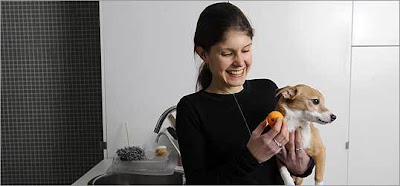Friday, March 6, 2009
Friday, February 27, 2009
Sunday, February 22, 2009
Boston Globe reports...

Q&A with Alissa Hamilton
What you're really pouring from that carton of orange juice
By Devra First
February 22, 2009
What could be simpler than a glass of orange juice? The beverage holds a place in the pantheon of wholesome American breakfast foods, on equal footing with toast, cereal, and eggs. It's pure and natural, ads tell us, and we buy both the sentiment and the product. More than 620 million gallons of orange juice are sold per year in the United States, according to market research from Nielsen.
Author Alissa Hamilton would have us take another look at the glass on the breakfast table. That simplicity is actually the result of a complicated process - juice stored in tanks for long periods, then goosed with flavor packs to taste like fruit again. Her book, "Squeezed: What You Don't Know About Orange Juice," due out in May from Yale University Press, reveals that orange juice, with its image as a natural Florida product, bears the fingerprints of chemists and is often shipped from South America.
Hamilton traces the history of the drink, first processed in the United States in the early 1900s as a canned juice that was said to taste like "battery acid." World War II ushered in the age of palatable processed orange juice, with the military seeking a source of vitamin C that soldiers would readily consume. In 1948, frozen concentrate was born, too late for the war effort but in time to help revive an ailing citrus industry, which was struggling with a surplus of fruit.
A further boost from Bing Crosby, who crooned about Minute Maid in radio ads, and OJ was on its way to becoming America's favorite breakfast drink. Since then, the citrus industry and its technologies have changed. The FDA tussled with manufacturers to set standards for orange juice. What remains constant? Marketing - some of it deceptive, says Hamilton.
If orange juice isn't harmful, it also isn't what it's portrayed to be. Consumers have a right to know what they are consuming, Hamilton says, and that is at the heart of her story. Ideas spoke with the author, a Woodcock Foundation-funded food and society policy fellow, by phone at her home in Toronto.
IDEAS: You write that the first question everyone asks when they hear about the book is whether orange juice is good for us. So - is orange juice good for us?
HAMILTON: I tell people if you like it, drink it, but not because you think it's good for you. You'd be better off with a whole orange than a glass of orange juice. It has more fiber and more vitamin C. But I'm not a dietitian. The book is not about whether you should drink orange juice and whether it's healthy. It's about how little consumers know about how popular and - in the case of orange juice - seemingly straightforward foods are produced and the repercussions for agriculture.
IDEAS: What isn't straightforward about orange juice?
HAMILTON: It's a heavily processed product. It's heavily engineered as well. In the process of pasteurizing, juice is heated and stripped of oxygen, a process called deaeration, so it doesn't oxidize. Then it's put in huge storage tanks where it can be kept for upwards of a year. It gets stripped of flavor-providing chemicals, which are volatile. When it's ready for packaging, companies such as Tropicana hire flavor companies such as Firmenich to engineer flavor packs to make it taste fresh. People think not-from-concentrate is a fresher product, but it also sits in storage for quite a long time.
IDEAS: What goes into these flavor packs?
HAMILTON: They're technically made from orange-derived substances, essence and oils. Flavor companies break down the essence and oils into individual chemicals and recombine them. I spoke to many people in the industry at Firmenich, different flavorists, and at Tropicana, and what you're getting looks nothing like the original substance. To call it natural at this point is a real stretch.
IDEAS: Why isn't orange flavor listed in the ingredients on the carton?
HAMILTON: The regulations were based on standards of identity for orange juice set in the 1960s. Technology at that time was not sophisticated at all . . . I don't think the concern is so much "are these flavor packs unhealthy?" The bigger issue is the fact that having to add flavor packs shows the product is not as fresh and pure as marketed.
IDEAS: It reminds me of McDonald's adding flavor to its fries to make them taste meaty, or beef extract to Chicken McNuggets, as we read about in "Fast Food Nation."
HAMILTON: The flavor industry can lend diversity to products that aren't really that diverse. Soft drinks are a perfect example: They're corn syrup and flavor. With orange juice, it's masking the processing procedure rather than the diversity of ingredients.
IDEAS: So parse the carton for us. For example, what is the phrase "not from concentrate" really about?
HAMILTON: In the '80s, Tropicana had a hold on ready-to-serve orange juice with full-strength juice. Then this new product, reconstituted orange juice, started appearing in supermarkets. Tropicana had to make decisions. Storing concentrate is much cheaper than full-strength juice. The phrase "not from concentrate" was to try to make consumers pay more for the product because it's a more expensive product to manufacture. It didn't have to do with the product being fresher; the product didn't change, the name simply changed. Tropicana didn't want to have to switch to concentrate technology.
IDEAS: A battle of the beverages?
HAMILTON: Yes. This is the orange juice equivalent of the cola wars. Minute Maid is probably the most familiar reconstituted orange juice, and it's owned by Coca-Cola. Tropicana is owned by Pepsi.
IDEAS: To what degree is orange juice still made from Florida oranges?
HAMILTON: Most concentrate is now from Brazil. Shipping it is relatively easy. Until recently, you could count on [Tropicana] Pure Premium being from Florida, but shipping technology has advanced. Companies like Tropicana have started shipping full-strength juice from Brazil rather than buying and squeezing in Florida. The majority of not-from-concentrate is coming from Florida-squeezed oranges, but that's certainly changing. The orange growing is moving to Brazil, which grows the most oranges for juice by far. Land is cheaper, and environmental regulations are almost nonexistent.
IDEAS: How is this affecting Florida growers?
HAMILTON: They are really struggling because of the growth of the industry. This product designed to help them has now effectively made them redundant. The groves are disappearing. They're being turned over in favor of condominiums. That was my ultimate aim, to show the connection between how processing does affect growing and how we as buyers - our lack of knowledge - does have implications for agriculture.
IDEAS: It strikes me that this is a timely book, with the Obama administration promising a review of FDA operations.
HAMILTON: I do think there's an opportunity. . . . It's been going on for decades with misleading marketing campaigns; I don't know why anybody isn't standing up to this. It's a perfect place for the FDA to start.
Devra First reports on food for the Boston Globe.
Tuesday, February 17, 2009
street art as status quo

Shepard Fairey is supposedly on a "quest to challenge the status quo and disrupt our sense of complacency through art." He was after all, arrested on his way to the opening of his retrospective at the I.C.A in Boston. As Peter Schjeldahl says "What isn't status quo about political rage? And have you met anyone not heavily medicated who strikes you as complacent lately? The retrospective is dated on arrival. Oddly, Fairey's splendid tour de force for Obama anticipated a new national mood, of serious-minded pragmatism, which makes ideological extremes seem sort of quaint. I found myself regarding the show as strangely wholesome, like a vaccine that defeats the virus it imitates." Obama personally thanked Fairey for helping him get elected. Where does all the White House and white box condoning leave Shepard Fairey with his countercultural street cred?
location location location
Maybe now that everyone is poor and terrified, industry will consider staying home.....
The Creamery on location
The Creamery on location
Sunday, February 15, 2009
taking back public space...
Just days after our adventure on the streets outside the New School (see Jan.29), one of our guest critics known as Poster Boy, was sent to Rikers. My understanding is that this article in the New York Times makes it all worthwhile....
Poster Boy
Poster Boy
Friday, February 6, 2009
Subscribe to:
Posts (Atom)

